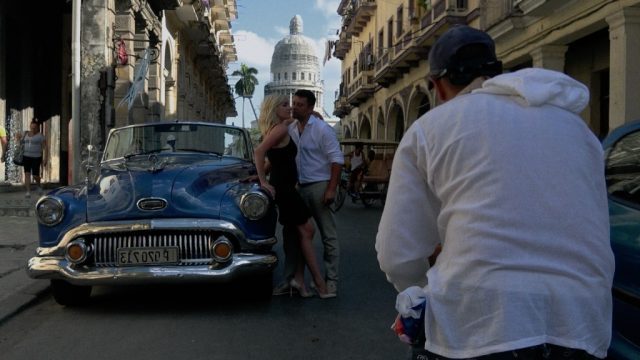
Epicentro takes a look at paradise, imperialism, war, slavery, freedom, utopia, and the power of cinema in Cuba
Who: Hubert Sauper, Eric Hynes, Beth Gilligan
What: Epicentro (Hubert Sauper, 2019)
Where: Museum of the Moving Image (August 28 – September 13, $12)
When: Sunday, August 30, free, 3:00; Saturday, September 5, free, 3:00
Why: Nothing was ever the same once Christopher Columbus and the Europeans arrived in Cuba on October 28, 1492. Oscar-nominated filmmaker Hubert Sauper explores more than five hundred years of Cuban history in the poetic and intimately honest Epicentro, which opens virtually August 28 through the Museum of the Moving Image here in New York City. Hubert Sauper (Darwin’s Nightmare, We Come as Friends) wanders through the streets of the island nation, taking his camera into apartments and businesses as he passes by burned-out buildings and cars, speaking with men, women, and children about such complex issues as utopia, dystopia, imperialism, racism, slavery, and freedom, relating it all to the invention of film. “Cinema projects our soul. Cinema moves humans to emotion,” a man tells a group of young students while screening documentary images of military battles and Georges Méliès’s fantastical 1902 A Trip to the Moon. The kids boo as America raises its flag in Cuba at the end of the Spanish-American War. “Havana means heaven, the dwelling place of angels, and it was the epicenter of three dystopian chapters of history: slave trade, colonization, and globalization of power, ingredients of modern empire,” Sauper narrates.
The film was inspired by Johannes Schmidl’s 2014 book, Energie und Utopie, and it isn’t hard for Sauper to find the indomitable energy of the Cuban people. Sauper eschews talking-head experts, historians, politicians, and well-known faces and instead lets the people tell their own story, especially two young girls who are wise beyond their years. At one point they have a rather remarkable conversation about Americans. “What happens here in Cuba is that we Cubans are used to . . . it is because they are treating other people like . . . they are superior to us, and they have more money and more of everything. They are richer than us. Some of us don’t know what goes on abroad,” one says. The other adds, “Some Cubans think that they are coming to harm us and treat us badly.” First girl: “Now there is that damned Trump.” Second girl: “Trump cares about nobody . . . he has no feelings.” First girl: “He does not lift the embargo, talks about the bad things in Cuba, and he closed the borders to migrants.” Later, on a rooftop, the first girl explains, “Nobody should be treated as if they were trash. Because black just like white means being a person.” As serious as the girls can get, however, they are later shown having a ball as they dress up and take pictures of each other pretending to be fashion models.
Sauper, who wrote, directed, photographed, and co-edited the film (with Yves Deschamps), also encounters prostitutes; a single mother; lots of people driving classic old cars from the Mafia era; a crowd mourning the death of Fidel Castro; a white photographer who refuses to pay his subjects (“to be photographed by me is an honor”); Oona Castilla Chaplin, Charlie Chaplin’s granddaughter, who teaches the kids about acting and music; and a tango-loving Bavarian man who notes, “Travelers who come here are people who have already traveled the world. And they are on a quest for the yet undiscovered paradise.” Meanwhile, a man in a bar complains, “I’d like to say that tourists are humanity, are human beings in their worst possible form. What kind of future is built by tourism? None. It only devours the future. It devours the past and culture, it renders everything superficial, into stupidity, into a relationship of power, constantly. . . . How much does making cinema resemble tourism?” But more than anything, Sauper captures the innate love Cubans have of their country, their history, their culture, and life itself. Their eyes glow with an infectious spirit even when they’re immersed in poverty, always ready to make the best of a situation, particularly the children, whom Sauper refers to in the credits as “little prophets.”
“Cuba is the beauty for the whole world,” a man says while pointing out the tiny island nation on a giant floor map in a theater. And Epicentro, winner of the Sundance World Cinema Grand Jury Prize for Documentary, is one beauty of a film.
On August 30 at 3:00, the Museum of the Moving Image will host a live Q&A with Sauper, moderated by film curator Eric Hynes, followed on September 5 at 3:00 by a live Q&A with Sauper and Coolidge Corner Theatre director of development and marketing Beth Gilligan.